Home
A comprehensive resource for safe and responsible laser use
Canada: New pilot laser glare protection eyewear using holographic optical filter
The most common laser color reported by pilots is green, representing approximately 90% of reports made to the U.S. Federal Aviation Administration. As of 2019, the most common green is 532 nanometers, produced by low-cost, high-power diode-pumped solid state laser pointers and handhelds.
metaAIR's first offering protects against 532nm green laser light, using holographic "nano-pattern layers". These can precisely reflect 532nm light while allowing high visibility for other wavelengths — crucial for pilots' night vision and for correct color discrimination of cockpit instruments and airport lighting. MTI adds an additional layer to improve color balance and discrimination, as well.
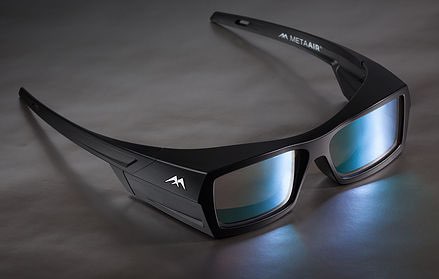
The eyewear is said to have an Optical Density between 2 and 5, meaning that it will attenuate the amount of 532nm light reaching eyes by 100 to 100,000 times. The primary goal is to reduce or eliminate visual interference effects such as flashblindness, glare and distraction. A secondary benefit is that attenuating 532nm light will also help protect against any potential eye injury. (Note that as of February 2019, no documented pilot eye injuries have occurred according to the U.S. FAA, U.K. CAA and Transport Canada after almost 75,000 reports of aircraft illumination. Laser/aviation safety experts consider visual interference to be a more significant safety concern than pilot eye injuries.)
The frame is wider at top, sides and bottom, to block light coming from directions other than the front.
MTI originally developed the holographic laser-reflecting technology for use in windscreens. The goal was to protect pilots without the need for eyewear. However, windscreen modifications require a slow, multi-year process of obtaining governmental and airline approval. In addition, the cost to modify windscreens is much higher than the cost of one or two pairs of eyewear. So eyewear was a natural choice for the first commercially available laser protection product from MTI. According to its metaAIR website, the company may also produce glare shields using the same technology.
MTI is taking pre-orders for its eyewear, distributed by Satair, which will be available "spring 2019."
From MTI's metaAIR website, accessed February 25 2019.
Canada: Satair, Metamaterials sign anti-laser glare protection distribution deal
Customers will include commercial and military pilots, both fixed-wing and rotary, in markets including commercial aviation, business aviation, search and rescue, police, medevac and military.
Satair is a part of the Airbus Customer Services unit. In 2014 Airbus brought Nova Scotia-based MTI into an innovation start-up program, working to commercialize aircraft windscreen film to protect pilots from laser glare and flashblindness. In June 2017 Satair and MTI signed a memorandum of understanding focused on the civil aviation market.
According to MTI, "Detailed market research and discussions with potential customers since then has confirmed that the overwhelming preference is for this innovative new product to be introduced to the market through individual eyewear and visor products which incorporate MTI’s laser glare protection technology."
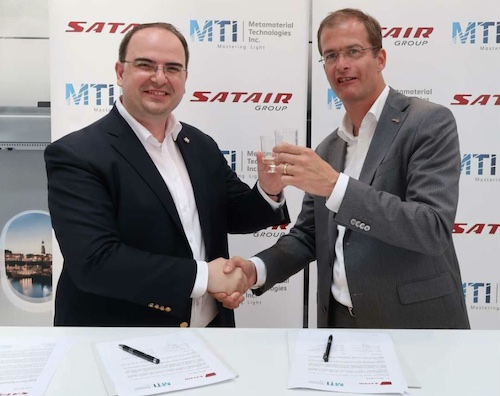
MTI's George Palikaras, founder and CEO (l), and Satair CEO Bart Reijnen (r) sign a distribution agreement at the October 2018 MRO Europe trade show for maintenance, repair and overhaul operations.
The October 2018 agreement widens the market and covers "eyewear and visor products that are developed or manufactured by MTI. These include, without limitation, all sub-components, sub-assemblies, piece parts, software and hardware."
MTI says their technology "is superior to other products currently on the market due to a unique and patented dielectric (non-metallic) optical metamaterial filter, which has been scientifically engineered to ensure that the pilots’ vision and interpretation of the surrounding environment is not disturbed during critical phases of flight."
From an October 17 2018 Metamaterial Technologies Inc. press release
UPDATED: In a February 19 2019 press release, Satair's customer solutions director says initial product applications will appear in the first quarter of 2019. He also said "The technology is highly scalable so it can be customised for a wide variety of platforms and other applications. In commercial aviation the green laser poses the biggest threat because the human eye is more susceptible to the green wavelength. For military markets the red laser may be the largest threat. The advantage of the MTI product compared to other products in the market is that it can be customised to the wavelengths the customer wants to be protected against. As we have exclusive distribution rights across civil aviation, military and defence, we are open to do business with leading OEMs of products such as night vision goggles, head-up displays, helicopter and fighter pilot helmets and aircraft flight deck visors. Other products in the market do not have the same quality, the same level of protection and colour balance that we have.
Thanks to Peter Smith and Leon McLin for bringing the February 2019 press release to our attention.
Canada: CDN $3M loan to MTI to manufacture laser eye protection glasses
The company’s metaAIR eyewear uses holographic technology to reflect unwanted wavelengths of light while passing others. According to MTI founder and CEO George Palikaras, the clear glasses do not affect vision like current solutions that can be too dark or affect colors.
“What is innovative in our eyewear is that it does not affect the pilot’s vision. So when you put them on you can still see that green is green, blue is blue and red is red,” Palikaras said at a May 4 2018 press conference. In the photo below, Palikaras is wearing the glasses, which reflect some wavelengths but otherwise appear clear to the wearer.
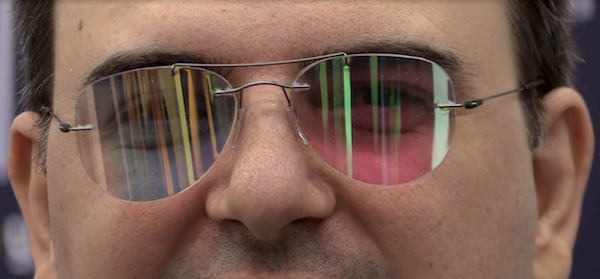
The glasses’ ability to reflect unwanted wavelengths were demonstrated by blocking 99.9% of the green light from a handheld Class 4 (> 500 milliwatts) 532 nanometer laser:
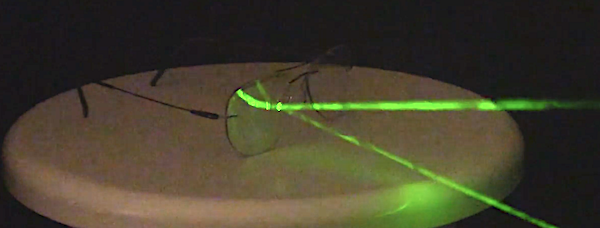
Palikaras said that besides pilots, MTI has had inquiries from the navy and from train operators. He cited incidents involving trains in Germany and Switzerland.
He said the glasses will be sold through MTI’s partner companies and directly to industry buyers.
As of May 2018, MTI has 27 employees, and is looking to hire 15 new full-time employees in production, marketing, research and development. MTI’s holographic technology is also used in developing aircraft windscreens with laser glare protection.
The $3M loan was provided by the Atlantic Canadian Opportunities Agency.
From the Chronicle Herald
Canada: Laser protection windscreen film offered by Airbus subsidiary for civil aviation
Satair Group is a subsidiary of Airbus which offers parts management, service and support for all types of aircraft. Satair expects to receive a Supplemental Type Certificate from the U.S. Federal Aviation Administration, the European Aviation Safety Agency, and Transport Canada Civil Aviation in early 2018. Other jurisdictions will follow.
The metaAIR film was invented and is manufactured by Metamaterial Technologies Inc. (MTI) of Halifax, Nova Scotia. The company previously worked with Airbus to evaluate, verify and test metaAIR for use in Airbus aircraft; initially for the A320 family. The Satair agreement will bring metaAIR to all commercial aircraft including Airbus and Boeing.
From a June 21 2017 MTI press release. For more details, click the link below for an interview with MTI’s George Palikaras, discussing the technology and this agreement.
Click to read more...
Canada: Airbus agrees to commercialize anti-laser windscreen material; eliminates need for laser protective eyewear
The film is not designed to fully block the laser light. It will significantly reduce the glare and temporary flash blindness effects that can occur when a laser is aimed at an aircraft cockpit. This in turn reduces the potential hazard of a laser illumination.
The announcement was made at a February 21 2017 press conference. In a press release kit photo, MTI’s founder and CEO, George Palikaras, demonstrated the laser-reflecting properties by holding up a windscreen that included MTI’s metaAIR film:
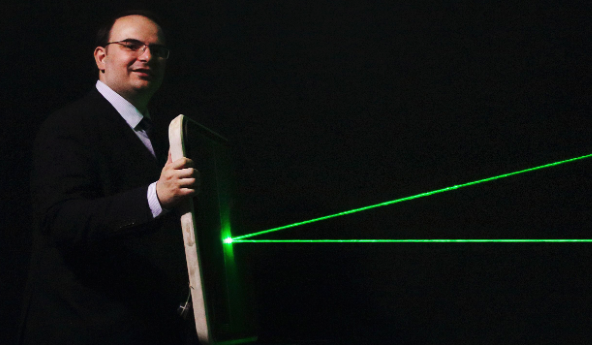
The press release did not indicate a time frame for introduction of the windscreens into service, nor details such as an estimated cost, or aircraft to be outfitted. An Airbus spokesperson did say that there are applications beyond the company’s commercial aircraft division. Palikaras said that metaAIR “can offer solutions in other industries including the military, transportation and glass manufacturers.”
For more detailed information on Airbus’ and MTI’s plans, see this page which includes interview Q&A questions with George Palikaras a few days after the February 21 press conference.
UPDATED April 14 2017: Metamaterials Technologies Inc. closed an $8.3 million round of funding. This will be used to support commercialization of the windscreen film and to add needed staff. MTI can produce metaAIR sheets 80 cm wide by 100 cm long, which is sufficient for standard cockpit windows that are 60 cm wide. However, the process is currently semi-automated and needs to be fully automated. MTI is also looking for new headquarters. From the Chronicle Herald.
UPDATED July 5 2017: MTI will be making its metaAIR anti-laser windscreen film available to non-Airbus aircraft, through aviation parts supplier Satair. An interview with George Palikaras goes into details.
Metamaterial Technologies Inc. issued a press release dated February 21 2017, which is reprinted below.
Click to read more...
Canada: UPDATED - Airbus to test windscreen anti-laser film
Lamda Guard’s “metaAir” film uses metamaterials, also called nano-composites, to reflect one or more laser colors without interfering with normal visibility. According to the company, the film can protect from beam angles up to +/- 50 degrees away from head-on. This has benefits when protecting cockpits against laser strikes, which can come from any angle.
It can be adhesively applied to glass or clear plastic; applications include eyewear, protective goggles and windscreens. Lamda Guard says that the Airbus tests on windscreens will mark the first time an optical metamaterial nano-composite has been applied on a large-scale surface.
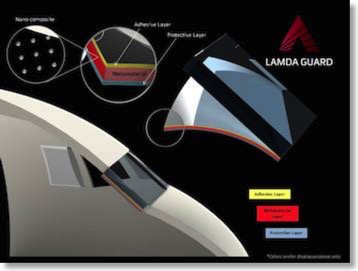
General schematic of metaAir film. Click for larger image.
The metaAir film can be engineered either to absorb or reflect the desired wavelength(s). For aircraft application, the reflection approach is being used in order to block undesired light wavelengths from entering the cockpit. The reflection bandwidth is currently in the 15-20 nanometer range.
For the most common type of green laser pointer -- responsible for 93% of FAA reported incidents in 2013 -- with a wavelength of 532 nm, the film would block light from about 522 to 542 nm. Additional wavelength blocking can be added as well, such as the 445 nm blue used in powerful handheld lasers such as the Wicked Lasers S3 Arctic that has up to 2 watts (2000 milliwatts) output.
Two key advantages of blocking laser light at the windscreen are that pilots do not have to carry or use laser protective eyewear, and there is absolutely no interference with the visibility of aircraft instruments. In preliminary tests, the anti-laser film had a narrow enough bandwidth that it did not interfere with airport lights seen outside a cockpit.
Because of ultraviolet degradation to the adhesive layer that adheres the optical metamaterial to the windscreen, the film would need to be replaced after about 5,000 flight hours. This translates into overnight replacement roughly once every three years. The optical metamaterial itself would not have a flight hour restriction.
In addition to piloted commercial aircraft windscreens, Airbus will also be investigating related applications such as piloted military windscreens, UAV camera protection, and sensor protection for satellites and airborne platforms.